Refueling household gas cylinders: rules for filling, servicing and storing cylinders
The gas supply habitual for the majority is far from a universally accessible service, since not everywhere there is a central gas pipeline. Gas cylinders in such places are not uncommon. And if the settlements are also far from large residential areas, then even refueling household gas cylinders can become problematic.
In such cases, it makes sense to have several cylinders in stock so that you can continue to use gas without any problems until the spare is refueled. We will talk about how the filling of “flasks” for the storage and consumption of blue fuel is carried out. We will introduce you to the rules that ensure the safety of refueling and operation.
The content of the article:
Suitable gas cylinders
The use of gas in everyday life is not accidental, because at cost it is cheaper than electricity, and sometimes technically simpler.
In addition to cooking, heating, etc. blue fuel is consumed in various fields of activity.
Types of vessels for storage and consumption
A wide range of uses made it necessary to develop a container for each of the spheres for the storage and operation of gaseous fuels. There are various modifications of cylinders of various volumes, which serve as suppliers of gas for hiking, on vacation and many more.
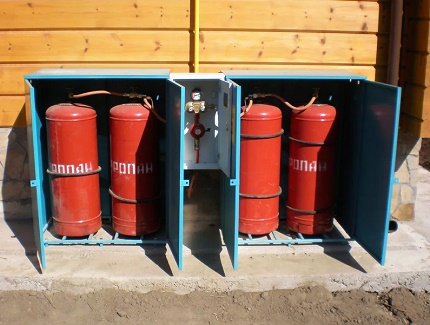
For tourism and recreation, it makes no sense to take a large volume balloon with you (well, if you do not plan a long vacation), but a small volume may not be enough or it will end quickly. Cylinders are not matches, you won’t take them with a margin, it makes no sense to carry excess weight, and nobody canceled the danger of moving vessels with blue fuel.
There are two main threats. The consequences of both dangers are the same. Since the cylinder is a vessel under high pressure, and the pressure itself is caused by a large amount of gas, which, when heated, can expand inside the cylinder, then it is explosive.
If you have to carry several gas cylinders with you on a camping trip if necessary, then at home (whether it is an individual house, a summer residence, etc.), the availability of spare gas tanks to serve the kitchen, bath, boiler room is understandable and understandable.
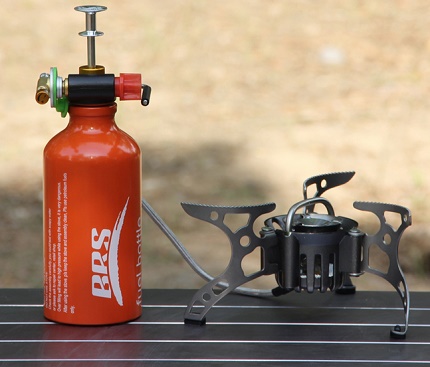
Note that the gas that is transported through the gas pipeline directly to the consumer is a mixture with a predominance of methane. But refueling gas cylinders is produced with a mixture of propane and butane, taken in various proportions.
Both main and liquefied bottled gas are colorless and odorless. In order to be able to accurately determine the leak, both mixtures odorize, i.e. enrich with swamp gas, methane, which has a characteristic unpleasant aroma.
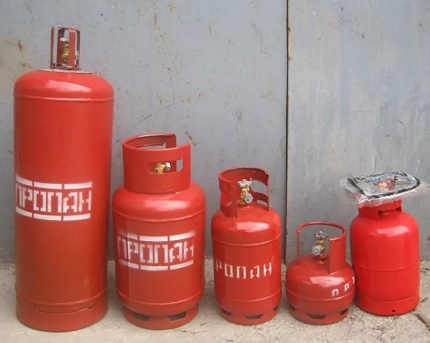
If you turn to the Internet search engines, you can find out that there are a lot of cylinders for transportation, domestic use, for work and gas storage. Not only the volume of the cylinders differs significantly, but also the technical performance during production, the service life, and even the design working pressure of the cylinders.
Technical features of cylinder production
How can a simple lay man not make a mistake when selecting the necessary type of cylinder and associated operational equipment? Let's look at these issues in more detail and turn to the main sources of information that can help in this - GOST.
Exactly at GOST All technical nuances are presented that are presented to cylinder manufacturers depending on the scope and characteristics of the fuel. Most of the regulatory documents relate to the production of industrial high-pressure vessels, since far from one or two types of gas are used in production.
For this reason gas cylinders should be painted in their own color; in a color that matches the gas that is stored in this cylinder. In addition to color, the cylinder must have an appropriate inscription, this can be seen in the picture below
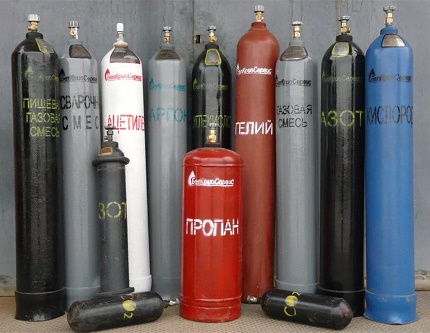
According to the rules regulated by state standards, household cylinders must be painted red and have the inscription “PROPAN” or “PROPAN-BUTAN” in white. This is a mandatory requirement for tanks containing liquefied combustible gas.
The main regulatory document that stipulates the conditions for the production of cylinders for domestic (not excluding industrial) use is GOST 15860-84, which is called “Welded steel cylinders for liquefied hydrocarbon gases at a pressure of up to 1.6 MPa. Technical conditions. "
Gas storage for individual use
The frequency with which refueling is required for cylinders depends primarily on the volume of consumption. Those. on the amount of gas equipment that consumes gas. In an individual residential building at connected gas stove and a heating boiler, gas consumption is much higher than when using a gas stove in a country house.
Cooking in the country (even with permanent residence) is temporary, therefore, consumption is much lower.In this case, refueling with a gas cylinder for a gas stove will be much less common than for a house in which a gas boiler is also installed.
The main reason for such differences in gas consumption lies in the fact that the design of the gas burner of the boiler differs significantly from the design of the cooking equipment burner. In such cases, it is difficult to do with one cylinder, even if the cylinder is large (50 l), it will have to be changed with enviable regularity.
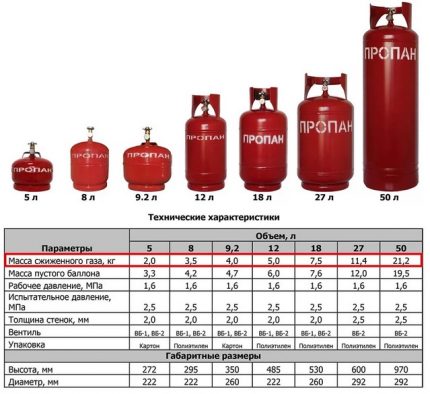
With high consumption, it makes sense to use an individual balloon installation, consisting of several cylinders. This option allows you to have in stock a significantly larger supply of gas, and replace empty cylinders less often.
However, one should not forget that an increase in the volume of stored gas entails an increase in responsibility for the technical condition of gas equipment.
Specially equipped place is usually located on the street fireproof cabinets. They carry out the fixation of the balloon equipment and their connection to the pipeline supplying the gas equipment.
Cabinets for individual balloon installations should be located in such places that they are at least five meters away from the passage paths of people (entrance to the house, etc.). They need to be firmly fixed. Cylinders inside cabinets must be in a stable position. It is recommended to fix them to protect against accidental fall.
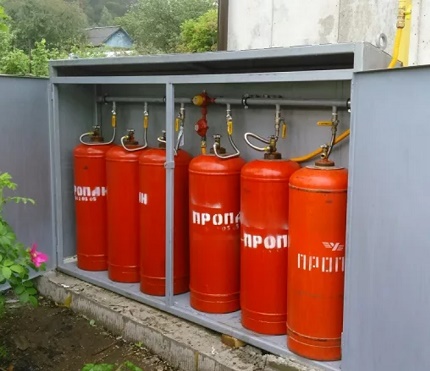
However, given the fact that the volume of gas stored is not so large, and there is also the possibility of its natural dispersion due to natural ventilation, this may not be necessary in individual balloon installations.
Maintenance and repair of gas equipment
An important issue that is often overlooked by the owners of a non-gasified private house or summer house is the maintenance of gas cylinders and individual cylinder systems. In large enterprises, service is carried out by personnel who have undergone training and knowledge testing on technology, while in individual farms no one passes such training.
When supplying and replacing cylinders, an organization that offers refilled cylinders is instructed with a record in the journal of the gas supplying structure about its implementation. Such briefing deals with the proper operation of already installed balloon equipment and safety measures during use.
Maintenance of balloon equipment and individual balloon installations should be performed by representatives of organizations that have specialized permissions for these types of work. During the work, not only the condition of the cylinders themselves, but also the cabinet of the individual balloon installation should be checked.
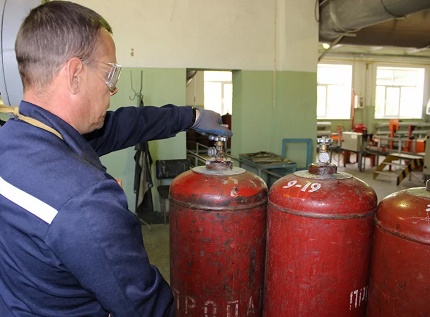
If any irregularities were detected during the maintenance process, they must be eliminated without fail.
A number of rules that are mandatory for those who use gas cylinders:
- cylinders at the installation site should not be directly heated;
- installation of gas equipment in the basement or basement is unacceptable, since gases can accumulate in the event of a leak;
- install cylinders near heating appliances (radiators, etc.) and a gas furnace should be no closer than 1m;
- the room in which the cylinders (and gas equipment) are installed should not have basements in which gas can accumulate.
Questions about whether it is possible and how to refill a gas cylinder directly at home are often asked by the owners of individual balloon systems. This is understandable, because for refueling they need to carry several cylinders, and sometimes at considerable distances.
The answer to this question is unequivocal - you can not refuel a gas bottle at home. There are several reasons for this and they relate to the technology of refueling cylinders.
Cylinder refueling technology
First of all, when taking the balloon on refueling the organization that will perform the work must check the technical condition of the cylinder. What is meant and what is hidden behind this technological definition?
If the cylinder is in unsatisfactory technical condition, then it may be refused to accept refueling. What specific defects can cause a failure should be considered in detail.
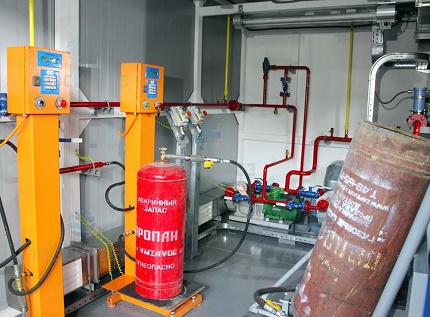
Major defects, the detection of which may refuse refueling gas bottle:
- if a malfunction of the shutoff valve has been detected (defective cylinder valve);
- in the presence of obvious damage to the integrity of the body - this may be obvious cracks in the weld, or traces of deep corrosion, a dent or bulge on the body;
- the absence of a plate with passport data or an unreadable plate is also a reason why they may refuse to accept the cylinder.
Unambiguously, a gas cylinder of a color that does not meet national standards and requirements, as well as a tank without a standard inscription, cannot be filled with blue fuel.
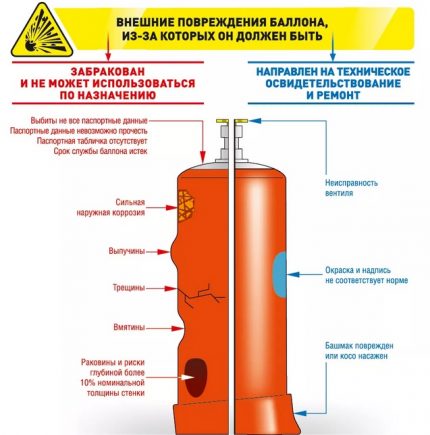
Requirements for refueling the tank and the inscription made by the refueling tanker have already been discussed above, technical malfunctions of the fittings and the casing are understandable claims.
Consider the label requirements. This is actually a cylinder passport, in which all its data are reflected, starting from the moment of production and ending with the date of the last verification (survey).
What exactly should be indicated on the plate:
- first of all, it is the brand of the cylinder and the mark of OTK of the manufacturer;
- the specific type of cylinder and the batch number in which it was released is then indicated;
- necessarily indicate the weight of the cylinder with an error of not more than 200 grams;
- accordingly, the date of production (release) of the container;
- the date the cylinder was last inspected and the date of the next verification;
- indicates the working pressure of the cylinder and its test pressure;
- the volume of the cylinder must be indicated, i.e. its capacity is accurate to 0.2l.
If there is no plate, identifying the cylinder will be problematic. Therefore, its condition must be monitored regularly. If the operating information is stamped directly on the cylinder body, then the inscription should be coated with colorless varnish and circled in white.
Labels that are not embossed on the case, but attached separately, should also be kept intact, and the data on the “balloon passport” should be clearly distinguishable and easy to read.
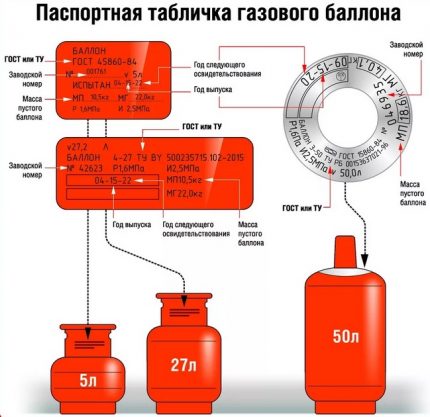
What is this data for? It is these characteristics that will be checked by the organization that refills the cylinder for compliance.Information about the weight of the container and its volume indicate how much gas can be charged into this container.
To make this clear, we will consider the main nuances of the technology for refueling household gas cylinders, which are prescribed in the typical instructions for refueling cylinders with propane or propanobutane a mixture.
Filling of cylinders should be carried out in accordance with the recommendations of the manufacturer, filling standards for the cylinder are:
- for technical propane, this is a volume of about 0.425 kg per liter of cylinder;
- for technical butane, this is about 0.4338 kg per liter of cylinder,
In this case, the liquid phase of the gas should not exceed 85% of the geometric volume of the balloon being filled.

The cylinder must be weighed before filling. It must have residual pressure if it has already been in operation. After filling, the cylinder must be weighed, and the plug of the valve fitting of the tank valve for storing and using gas is checked for leaks using soaping all places where leaks are possible.
Defect check
Refueling is carried out if, upon receipt of the cylinder, refueling no defects were found, and the verification period has not yet expired. If the verification period is missed, then the cylinder requires not only maintenance, but tests that can only be performed by a specialized organization that owns the necessary equipment.
Examination allows you to identify defects that may not be visible to the naked eye, or even be inside the cylinder body. What specific manipulations with the cylinder will be performed should be considered in more detail.
A hydraulic cylinder test method is used to detect microcracks. According to this technique, a pressure of 2.5 MPa is pumped into a cylinder filled with water. Testing duration not less than 1 minute.
Then the pressure drops to the normal operating level, after which the cylinder is inspected with all the welds tapped (tapping a hammer having a weight of 0.5 kg).
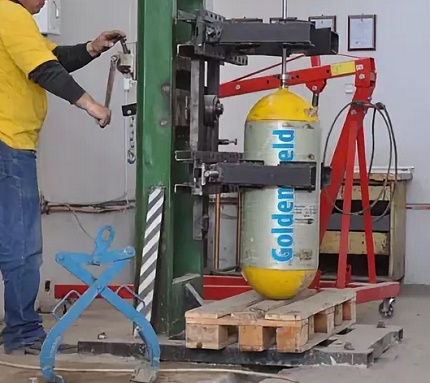
The final stage in the study of the technical condition of the cylinder is pneumatic research. This is the location of the cylinder in a volumetric container with water. From the upper parts of the container to the surface of the liquid into which the vessel is immersed, there should be 3-4 cm.
A pressure of 1.6 MPa is injected into the cylinder for at least 2 minutes. If there is a leak in the balloon, it is easy to identify visually from the traces of the bubbles. If the pneumatic test did not reveal any defects in the body, then the cylinder can be dried and sent for recharging.
According to the current regulatory acts, the service life of household gas cylinders should not exceed 20 years. During the use of the cylinder, it can be repaired, but no more than 2 times and with subsequent examination after restoration of technical characteristics.
Inspection of cylinders should be performed at least once every five years, with the obligatory indication on the plate of the date of the survey and the date of the next inspection.
Conclusions and useful video on the topic
Explosion of a gas cylinder under the influence of high temperature on the body:
We examined the main aspects that relate to the operation of gas cylinders in everyday life, examined the issues of operation and maintenance of gas equipment. In addition, they listed the main technical requirements for reloading cylinders and their inspection by specialized organizations.
Possession of useful information will avoid a lot of dangerous situations. The attentive reader will be able to determine whether his balloon is subject to refueling. It will be able to control the work of employees of the organization engaged in the replenishment of individual tanks for blue fuel.

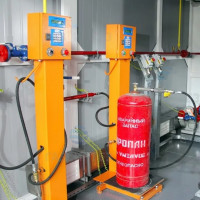 Filling rules for household gas cylinders at gas stations: safety standards and requirements
Filling rules for household gas cylinders at gas stations: safety standards and requirements 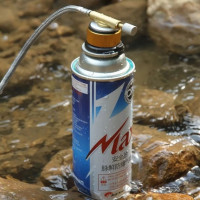 Do-it-yourself gas cans for burners: instructions for different types of cylinders
Do-it-yourself gas cans for burners: instructions for different types of cylinders  Characteristics of typical 50 liter gas cylinders: design, dimensions and weight of the cylinder
Characteristics of typical 50 liter gas cylinders: design, dimensions and weight of the cylinder  Gas cylinder cabinet: cylinder storage requirements + cabinet selection and installation tips
Gas cylinder cabinet: cylinder storage requirements + cabinet selection and installation tips 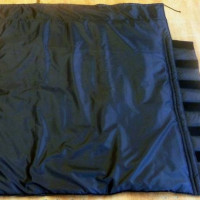 How does a thermal blanket work for gas cylinders: features of the device and use + selection tips
How does a thermal blanket work for gas cylinders: features of the device and use + selection tips  Types of gas cylinders: full classification + analysis of labeling
Types of gas cylinders: full classification + analysis of labeling  How much does it cost to connect gas to a private house: the price of organizing gas supply
How much does it cost to connect gas to a private house: the price of organizing gas supply  The best washing machines with dryer: model rating and customer tips
The best washing machines with dryer: model rating and customer tips  What is the color temperature of light and the nuances of choosing the temperature of the lamps to suit your needs
What is the color temperature of light and the nuances of choosing the temperature of the lamps to suit your needs  Replacement of a geyser in an apartment: replacement paperwork + basic norms and requirements
Replacement of a geyser in an apartment: replacement paperwork + basic norms and requirements